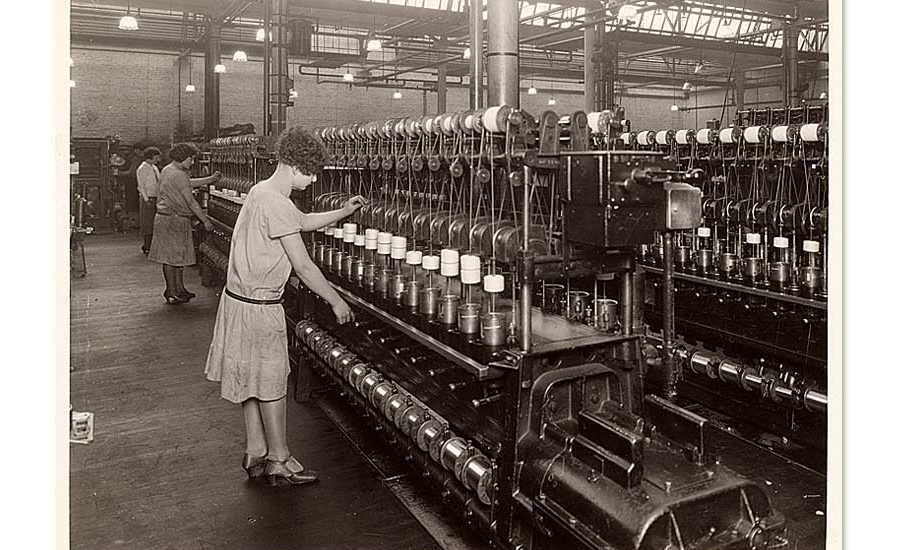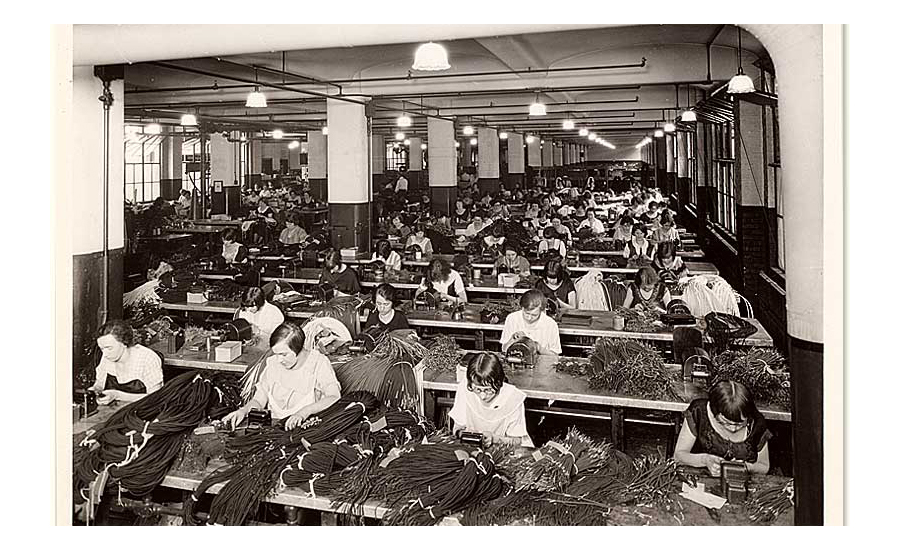The Hawthorne Works








At one time, Cicero, IL, was famous for two things that had absolutely nothing in common: Al Capone and Western Electric. The blue-collar town on the West Side of Chicago served as headquarters for the notorious gangster. But, Cicero also was home to a sprawling manufacturing complex called the Hawthorne Works, which produced some of the most technically advanced products in the world.
Western Electric served as the manufacturing arm of the Bell System for more than 100 years. It produced many of the breakthrough technologies developed by scientists at Bell Laboratories. In addition to telephone and telegraph equipment, Western Electric assembled typewriters, sewing machines, electric fans, vacuum cleaners, microphones, mimeographs, vacuum tubes, radios, motion picture sound systems, radar equipment and transistors.
The Hawthorne Works was the cradle of numerous manufacturing innovations, such as the first public address system and a private railroad with more than 10 miles of track that was dubbed "the biggest little railway in the world." When it opened in 1906, the huge facility was hailed as the first fireproof factory in the world. Production space was compartmentalized by heavy fire walls with tin-clad doors at their openings. An automatic sprinkler system extended throughout most of the complex, which comprised more than 100 buildings. The steel-framed structures had brick walls, concrete floors and tile roofs.
Inside the Hawthorne Works, more than 40,000 people designed, assembled and tested a wide variety of switchboards, cable and wire harnesses, relays, switching systems and other state-of-the-art telecommunications equipment that most people never think about when they make a phone call or send a fax. Western Electric boasted that it manufactured "43,000 varieties of telephone apparatus."
The world’s first high-vacuum tube was manufactured at the plant in 1913. The facility pioneered the condensor microphone in 1916 and air-to-ground communications in 1917. In 1919, Western Electric gave the desktop telephone its first dial. A few years later, it created the first successful sound system for the movie industry.
During World War II, Western Electric produced advanced radar systems. Postwar products included electronic telephone switching systems, mobile telephone systems and microwave radio relay communication systems.
The 5-million-square-foot Hawthorne Works also pioneered quality control practices and principles. In fact, two "pillars" of the quality movement, W. Edwards Deming and Joseph Juran, started their careers at the Hawthorne Works, which was the first factory to use widespread visual inspection and testing to detect manufacturing problems. The inspection department alone employed more than 5,000 people. Centralized inspection sites were organized to check for quality at the end of production lines.
During the 1920s and early 1930s, the Hawthorne Works was the site of a series of landmark human behavior studies that examined how fatigue, monotony and supervision on an assembly line dramatically affected productivity. The results of those famous tests are referred to as the Hawthorne Effect.
The first phase of the studies, known as the Illumination Experiments, was conducted between 1924 and 1927 under the direction of Vannevar Bush, an electrical engineer at the Massachusetts Institute of Technology who later developed systems that made the computer possible. The intent was to find the level of illumination that made the work of female coil winders, relay assemblers and small parts inspectors more efficient.
Workers were divided into test and control groups. Lighting for the test group was increased from 24 to 46 to 70 foot-candles. Production of the test group increased as expected, but production of the control group increased approximately the same amount.
To understand these unexpected results, Harvard University professors Elton Mayo and Fritz Roethlisberger conducted a second phase of tests, called the Relay Assembly Test Room Experiments, between 1927 and 1932. They focused their research on the assembly of telephone relays. Hundreds of women worked in a large room where they assembled 40 different parts into the mechanical relays that were needed for telephone switching in the days before solid-state electronics.
The repetitive assembly process consisted of putting together a coil, armature, contact springs and insulators in a fixture and securing the parts by means of four machine screws. Each assembly took approximately 1 minute to complete. Under normal conditions with a 48-hour work week, including Saturdays, the assemblers produced 2,400 relays a week each.
Elton and his research team selected six women whose prior production rates were known. They were removed from the large assembly hall to a special test room with standard assembly benches, tools and equipment. The researchers wanted to test the effects of changes in length and frequency of rest periods and hours worked.
The test room was separated from the main assembly department by a 10-foot-tall wooden partition. Temperature, humidity and lighting conditions were controlled, and an observer in the room recorded events as they happened.
Five assemblers worked at the benches, while one woman procured and distributed parts. The production rate was monitored as each completed relay was placed on a chute, activating an electric counting gate as it passed down.
The women had no supervisor, but they increasingly assumed responsibility for their own work and were allowed to share in decisions about changes in their work. The experiments consisted of 23 changes in the working environment. For instance, rest breaks were added and maintained at various lengths and periods of time. Shorter workdays and elimination of Saturday hours were also tried.
Output increased no matter how physical conditions were varied. In fact, even when conditions were returned to what they had been before, productivity remained 25 percent above its original value. Absenteeism was only a third of that in the main assembly room. Output averaged 3,000 relays a week per assembler. Physical changes appeared to have no effect on output rate.
A third phase of study, called the Bank Wiring Observation Room Experiment, was conducted from 1931 to 1932. It involved a group of 11 men who assembled terminal banks used in telephone exchanges. However, the assemblers who participated in the study restricted production because they were distrustful of the goals of the project. The men had established their own standard of a fair day’s work. Despite the piecework pay scale that existed, they ridiculed and abused any assembler who tried to work faster or slower than the group norm.
Mayo attributed the results of the first two studies to the pride of the women in being part of something important and the satisfaction of having some control over their own destiny. Merely by asking for their cooperation in the test, Mayo believed the investigators had stimulated a new attitude among the employees. The assemblers considered themselves to be part of an important group whose help and advice were being sought by the company.
The single most important discovery of the Hawthorne experiments was that workers had a strong need to cooperate and communicate with fellow workers. The study discovered that workers did not respond to the classical motivational approaches suggested in Frederick W. Taylor’s Scientific Management theory. According to Taylor’s popular theory, workers were motivated solely by self-interest. Scientific management theorists assumed that workers desired to perform their work with a minimum of effort and to receive more money.
According to Mayo, the six individuals involved in the Hawthorne study became a team. In his research findings, published in a 600-page book, Mayo concluded: "...the eager human desire for cooperative activity still persists in the ordinary person and can be utilized by intelligent and straightforward management." In other words, the mere act of showing people that you’re concerned about them usually spurs them to better job performance.
Mayo’s studies suggested that consultation between labor and management gave workers a sense of belonging to a team. The Hawthorne experiments encouraged the development of human factors engineering and ergonomics, and they created pressure for management to change the traditional way of managing human resources. The studies encouraged participative support at the lower levels of the organization in solving organization problems.
In addition, the Hawthorne studies fostered a more open and trusting environment that put greater emphasis on groups rather than just individuals. Today, it’s estimated that 50 percent of any successful training session can be attributed to the Hawthorne Effect.
The Hawthorne Works closed its doors in 1983. The main building was demolished and the site was turned into a shopping mall. However, the cable plant, water tower and several other buildings still stand. Western Electric shifted assembly activity to newer plants.
In 1984, the U.S. Justice Department forced a controversial breakup of the Bell System, which resulted in deregulation of the telecommunications industry. After 112 years, the Western Electric name was abandoned. The company was absorbed into AT&T Technologies, which is now known as Lucent Technologies.
To learn more about the Hawthorne Works and other factories that made Chicago a production powerhouse, see Made in Chicago: The Windy City’s Manufacturing Heritage.
Looking for a reprint of this article?
From high-res PDFs to custom plaques, order your copy today!











